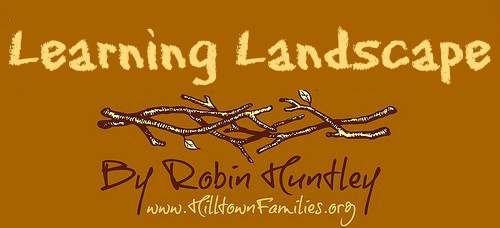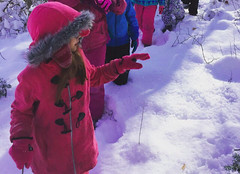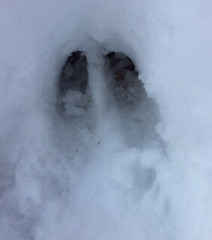Learning Landscape for January: Tracking to Learn Winter Habits

The January Landscape
January in New England is bleak. Deep snow covers the ground, and temperatures hover – unwavering – right around zero. Modern humans instinctively shy away from what we see as a harsh landscape, but all around us, creatures are going about their lives. If we project our human interpretation of winter upon the scene, it appears dormant, bleak, perhaps even depressing – how could anything be alive within it? Yet all around us, the natural world is indeed very much alive, directly experiencing winter as another moment in its existence. Creatures roam about, insects are literally snug as bugs underground, and trees stand tall and unfrozen, filled with natural antifreeze.
This is not to say, however, that winter does not have an impact on nature. Each species changes its patterns to live in alignment with its surroundings, and just as January elicits certain behaviors and attitudes from humans, it does in animals as well.
You can prove this to be true yourself by exploring the natural world during this frosty month. Look for signs of life, and compare the winter habits of native creatures to their habits in other seasons. Notice how well they align with the conditions afforded by the season; their survival depends upon it.
Artifacts for Learning

Walking the January woods is beautiful, and can be quite a treat – especially in newly fallen snow. Whenever snowfall arrives, explore a familiar natural space a day after the weather returns to its winter norm. Tracks will litter the ground, crisscrossing the once bare ground between trees, rock walls, bushes, and lawn – if you know where to look.
The secret to noticing an abundance of tracks is searching for them in a place you know quite well. If you are working to become closely aligned with a space, you’ll know its shape, its patterns, and its energy closely enough to notice almost any tracks in fresh snow. If you’re familiar with the general trend of a place, you’ll also know enough about it to be able to tell the difference between real tracks and the “phantom” tracks left by snow falling from branches or rolling down banks.
This month’s artifacts are only truly artifacts when photographed, sketched, or even better when examined so carefully that their qualities are memorized.
Small Mammals
They’re plentiful in the north woods and can be found in even the least wild of spaces (in fact, some are easier to find in overwhelmingly human spaces). Though we’ve historically taught one another that small, furry creatures hibernate all winter, they actually move around quite a bit. Mice, squirrels, chipmunks, rabbits, and some of their relatives make a habit of moving around in winter, both for warmth purposes and to seek out easily accessible food sources.
- LOOK at the base of trees, especially ones with low-hanging branches. Be on the lookout for fallen trees or clumps of branches protruding from the snow, as these can be homes or hiding places for small mammals, too.
- IDENTIFY by finding a series of nearly identical imprints in the snow, usually in line with one another. A vertical hole or other tunnel-like openings in the snow nearby the tracks is a good sign they’re real ones!
- COLLECT evergreen seeds or cones (a food source), and look carefully for scat so long as you can collect it safely using proper methods.
Birds
Avian creatures of all sizes are active throughout the winter. Plentiful and oft-spotted species include blue jays, woodpeckers, chickadees, juncos, nuthatches, turkeys, and crows. Despite their lean mass, birds are hardy and overwinter well in this landscape. Unlike most other creatures, birds can be tricked into coming close enough for human observation from indoors though feeding – but they’re more of a prize to spot when it happens naturally!
- LOOK first underneath your bird feeders, if you must. Then, venture out to search for natural food sources, and look beneath them. Sumac is a winter favorite, as are evergreens, whose cones continue to drop bits of seed throughout the winter. Birds who depend primarily on flight hop while they are on the ground and their tracks look like the work of a toddler with a stamp. Birds who use their feet for transportation often walk in a straight line much like humans.
- IDENTIFY by their uniform shape and size. You may also notice streaks in the snow that look like scratches – these are left by wings, and usually, indicate that a bird took flight. Bird tracks are generally close together, showing a short stride.
- COLLECT samples of food sources (seeds) in small amounts for study. Feathers are more often found in warmer months.
Deer

The plentiful and majestic deer is one of the most classic animals to track, likely because it’s so easy to spot and identify their tracks! They’re predictable, and frequent the same places day after day. They leave a variety of signs, and they’re easy to study and admire.
- LOOK anywhere that you’ve seen a deer before! If you know your natural space well, simply go follow their paths. If you don’t, just take a walk. If there are deer around, you’ll find their tracks soon enough. Try thin woods, the edges of fields, and anywhere there’s an oak or apple tree.
- IDENTIFY based on their hallmark shape, and the straight line that they follow. If you find a place where there is a large concentration of tracks together, examine nearby plants for a browse – a spot where deer nibbled the ends of the branches. Check trunks of small trees for rubs, places where deer have rubbed away bark.
- COLLECT smashed acorns and bitten apples! Take a scat sample if you’re prepared to do so using proper handling methods.
January Library for Tracking
The collection of titles listed below can be used to spark, support, or continue studies related to learning the winter habits of the creatures around you by discovering and identifying their tracks.
Children
- Whose Tracks Are These? A Cluebook of Familiar Forest Animals by James Nail
- Animals in Winter (Let’s Read and Find Out Science) by Henrietta Bancroft
- Over and Under the Snow by Kate Messner
- The Big Snow by Berta and Elmer Hader
- Tom Brown Jr.: The Art and Science of Tracking by Tom Brown
Teens & Adults
- Tom Brown’s Field Guide: Nature Observation and Tracking by Tom Brown
- Mammal Tracks and Sign: A Field Guide to North American Species by Mark Elbroch
- Bird Tracks and Sign: A Field Guide to North American Species by Mark Elbroch
- Animal Tracks of New England by Tamara Hartson and Mark Elbroch
Download a .pdf of this month’s Learning Landscape to share with your family!
Robin Morgan Huntley, Community-Based Education Correspondent

A native to Maine, Robin joined Hilltown Families in early 2011 as an intern and remained over the years volunteering as a community-based education correspondent until moving back to Maine in 2016. Robin is a graduate of Antioch University with a masters in education. Her interests in the field of education include policy and all types of nontraditional education. For her undergraduate project at Hampshire College, Robin researched the importance of connecting public schools with their surrounding communities, especially in rural areas. Robin currently lives with her husband, cats, dog, and bunnies in Maine. She is a 3rd-grade teacher and the founder of our first affiliate community-based education network, Dirgio Learning.
 Hilltown Families
Hilltown Families 




























